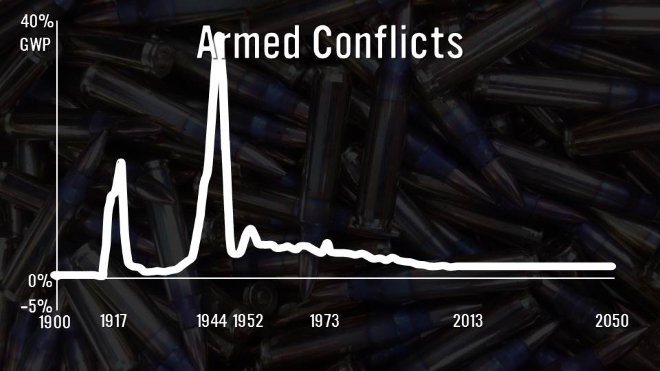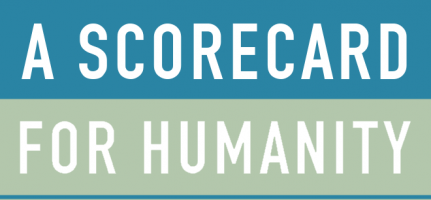A Scorecard for Humanity: Armed Conflict, Blomberg Hess
Assessment Paper
A version of the working paper is available for download here. The finalized paper has been published in How Much Have Global Problems Cost the World? A Scorecard from 1900 - 2050 by Cambridge University Press.
An Assessment Paper on armed conflict was written by S. Brock Blomberg and Gregory D. Hess and released as a chapter in How Much Have Global Problems Cost the World?
Facts and figures on armed conflict

War has a heavy economic and human cost. The internet images are more immediate and vivid than ever but our perception of ubiquitous conflict is wrong. In the twentieth century conflict killed 140 million, including 78–90 million in the two world wars.
The good news is that future higher, current or lower conflict and military-spending scenarios show small differences compared to the dramatic decline in costs from conflict across the past century: the First World War cost about 20% of world GDP and the Second almost 40%. When looking at the cost of conflict, the economists estimate the simple stuff used for military action. If one also takes into account the lives lost in battle, the estimates increase by about 50%.
On average, the 20th century military cost about 5% of GDP per year. Yet, since the Korean war peak of 7%, global costs have declined steadily through 3.5% in 1980 to about 1.7% now. Even for a pessimistic outlook till 2050, this might only go up to about 1.8% -- and with a more optimistic outlook, it could decline further to 1.6%. The important takeaway is that the heavy military costs of the 20th century has been turned into what looks like a permanent peace dividend.
Short summary
Conflicts, of various sizes and purported purposes, cast a long and dark shadow on the lives of many and on the histories of nations and peoples. Theories of conflict abound – for wars between nations, internal civil conflicts, and terrorist operations – primarily based on national or group leaders convincing followers to take up a fight for some purpose, noble (to advance an idea, a religion, a culture, a form of government) or otherwise (to appropriate). While leaders, on occasion, do profit from conflict, they do so less often than they might ever imagine. Indeed, leaders, depending on institutional constraints, can separate the spoils of war (land, resources) from the dim costs of war.
The men and women who conduct the battles, however, can seldom avoid the costs of war, and so are fully saddled with the loss of life, limb, loved ones, livelihood, and way of life. Nor are the soldiers’ interests fully reflected in the interests of those who make the decision to initiate, continue or to change the course of battle. In his famous letter to his World War I commanding officer, Lt. Siegfried Sasson of the Royal Welsh Fusiliers, clearly speaks of wrote:
“I believe that the war upon which I entered as a war of defence and liberation has now become a war of agression [sic] and conquest. … I have seen and endured the sufferings of the troops and I can no longer be a party to prolonging these sufferings for ends which I believe to be evil and unjust. I am not protesting against the conduct of the war, but against the political errors and insincerities for which the fighting men are being sacrificed. On behalf of those who are suffering now, I make this protest against the deception which is being practised upon them; also I believe it may help to destroy the callous complacency with which the majority of those at home regard the continuance of agonies which they do not share and which they have not enough imagination to realise.’’ July, 1917
Despite the inherent wastefulness of conflict, we continue to observe it in all its infinite manifestations. And there should be no doubt that we will certainly continue to observe it throughout this century. As he remarked in his speech in accepting the 2009 Nobel Prize for Peace, U.S. President Barrack Obama stated “We must begin by acknowledging the hard truth: we will not eradicate violent conflicts in our lifetimes,” and that “There will be times when nations — acting individually or in concert — will find the use of force not only necessary but morally justified.”
Violent conflict is thus wasteful and inevitable – a cheerless combination. But this odd coupling, perhaps surprisingly, may help us to understand how to create a less violent world. Indeed, the key to reversing the inevitability of violent conflict may lie in our better understanding and coming to grips with its wastefulness. In other words, by better understanding the costs of war we may be able to chip away at the existence of conflicts, and build institutions to better insure against their return.

